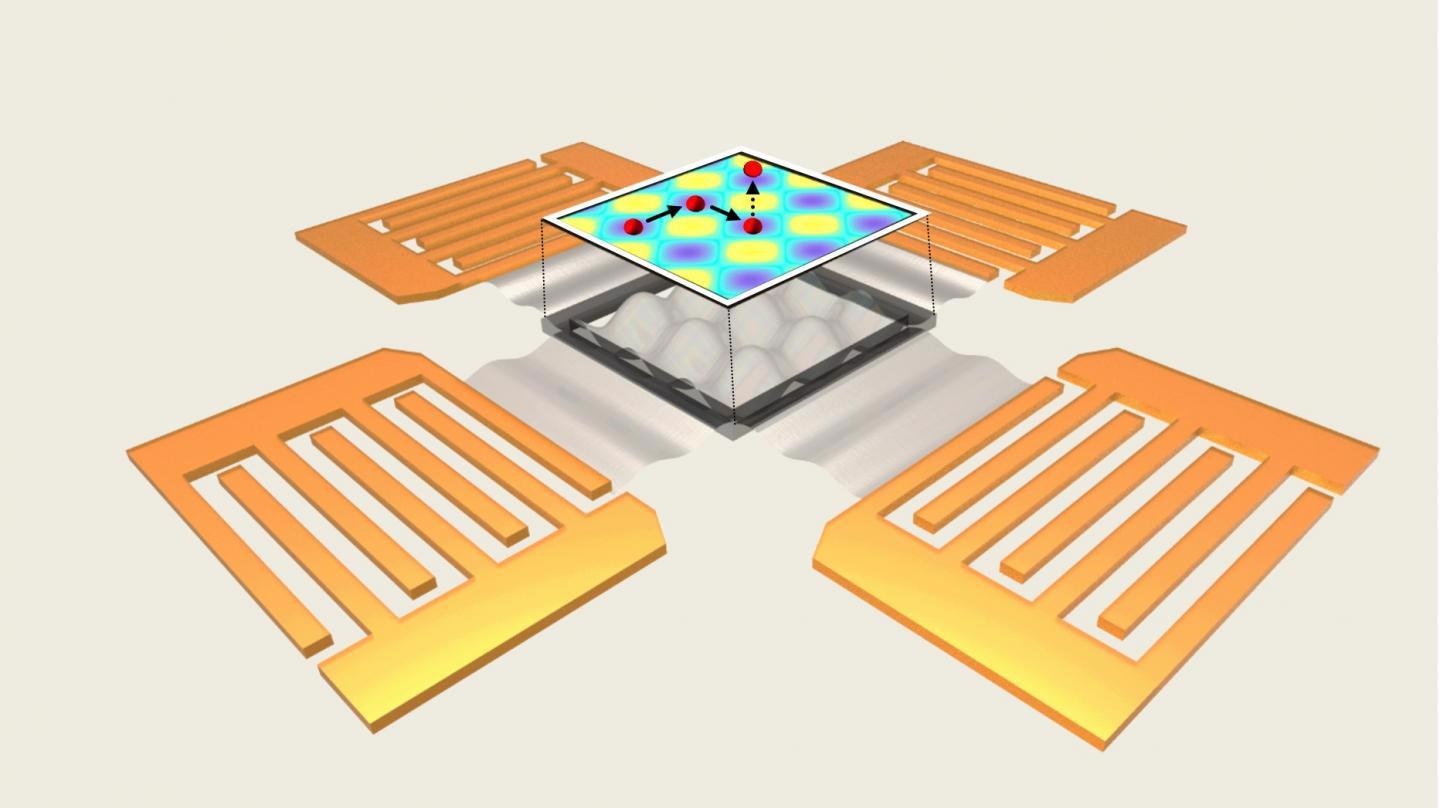Jun 23 2021
A new system developed by engineers at Duke University could help manipulate particles nearing the minuscule DNA diameter of 2.5 nm with the help of sound-induced electric fields.
 This new biomedical device manipulates particles as small as DNA (2.5 nm) with sound-induced electric fields. Four transducers send sound waves into a substrate that creates electricity as it vibrates, producing patterns of electric-acoustic waves that control particles in the liquid-filled chamber above. Image Credit: Peiran Zhang, Duke University.
This new biomedical device manipulates particles as small as DNA (2.5 nm) with sound-induced electric fields. Four transducers send sound waves into a substrate that creates electricity as it vibrates, producing patterns of electric-acoustic waves that control particles in the liquid-filled chamber above. Image Credit: Peiran Zhang, Duke University.
The method named “acoustoelectronic nanotweezers” offers a label-free, dynamically controllable technique for shifting and trapping nanoparticles over a huge area. The technology holds potential for applications in various fields from condensed matter physics to biomedicine.
The study was published online in the journal Nature Communications on June 22nd, 2021.
For several emerging technologies, accurate control of nanoparticles is a crucial capability. For instance, isolating exosomes and other small biological molecules from blood could result in new kinds of diagnostic tests for the early detection of neurodegenerative diseases and tumors. Proper positioning of engineered nanoparticles in a particular pattern prior to fixing them in place can help make new kinds of materials that have highly tunable properties.
Tony Jun Huang, who is working as a William Bevan Distinguished Professor of Mechanical Engineering and Materials Science at Duke, has been studying acoustic tweezer systems that work based on sound waves to handle the particles, for more than 10 years. However, it becomes hard to drive things around with the help of sound when their profile falls below that of some of the smallest viruses.
Although we're still fundamentally using sound, our acoustoelectronic nanotweezers use a very different mechanism than these previous technologies. Now we're not only exploiting acoustic waves, but electric fields with the properties of acoustic waves.
Joseph Rufo, Graduate Student in Huang’s Laboratory, Duke University
Rather than making direct use of sound waves to shift the nanoparticles, Huang and Rufo, together with Peiran Zhang, a postdoc in Huang’s laboratory, have utilized sound waves to make electric fields that offer the push.
The functioning of the new acoustoelectronic tweezer method is based on placing a piezoelectric substrate — a thin material that helps make electricity in reaction to mechanical stress — under a small chamber loaded with liquid. Four transducers are arranged on the sides of the chamber, which transmit sound waves into the piezoelectric substrate.
Such sound waves tend to bounce around and communicate with one another to make a stable pattern. Since the sound waves cause stresses inside the piezoelectric substrate, they also make electrical fields. Such fields couple with the acoustic waves in a way that makes electric field patterns inside the chamber above.
The vibrations of the sound waves also make the electric field dynamically alternate between positive and negative charges. This alternating electric field polarizes the nanoparticles in liquid, which serves as a handle to manipulate them.
Peiran Zhang, Postdoc in Huang’s Laboratory, Duke University
The consequence is a mechanism that combines a few of the strengths of other nanoparticle manipulators. Since the acoustoelectronic nanotweezers produce an electromagnetic response in the nanomaterials, there is no need for the nanoparticles to be conductive on their own or tagged with any kind of modifier. Moreover, since the patterns are made with sound waves, their properties and positions can be simply and rapidly altered to make a range of options.
In the prototype, the scientists displayed nanoparticles that are positioned into a checkerboard and striped pattern. They also dynamically push separate particles in an arbitrary manner, spelling out letters like D, U, K and E.
The scientists show that such aligned nano-patterns could be shifted onto dry films with the help of intricate nanoparticles like carbon nanotubes, 1.4-nm dextran and 3.5 nm proteins frequently utilized in biomedical research.
Moreover, the researchers demonstrate that all of this can be achieved on a working area that is tens to hundreds of times bigger than existing advanced nanotweezing technologies.
This study was financially supported by the National Institutes of Health (R01GM132603, R01GM135486, UG3TR002978, R33CA223908, R01GM127714), the United States Army Medical Research Acquisition Activity (W81XWH-18-1-0242), and the National Science Foundation (ECCS-1807601).
Journal Reference:
Zhang, P., et al. (2021) Acoustoelectronic nanotweezers enable dynamic and large-scale control of nanomaterials. Nature Communications. doi.org/10.1038/s41467-021-24101-z.